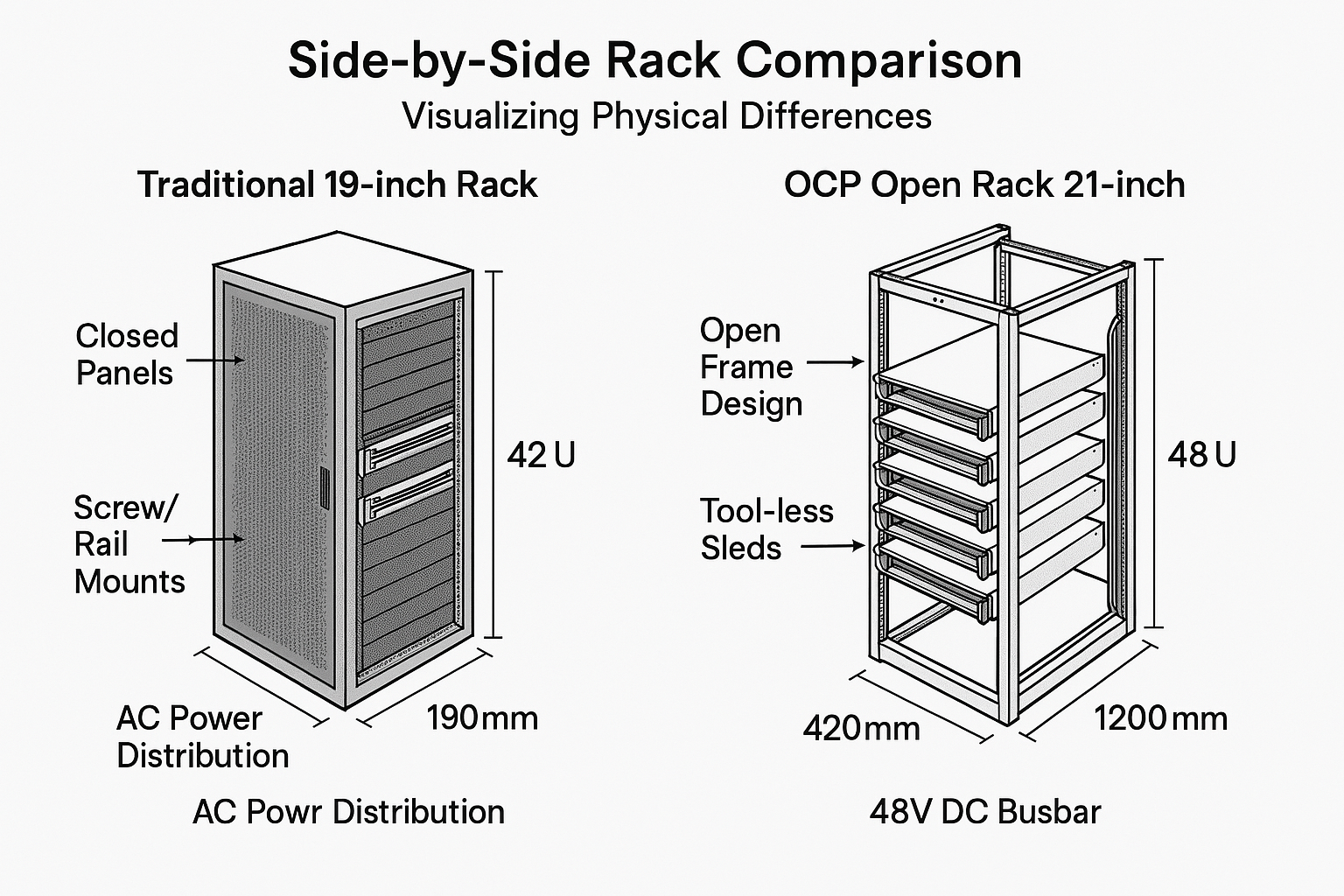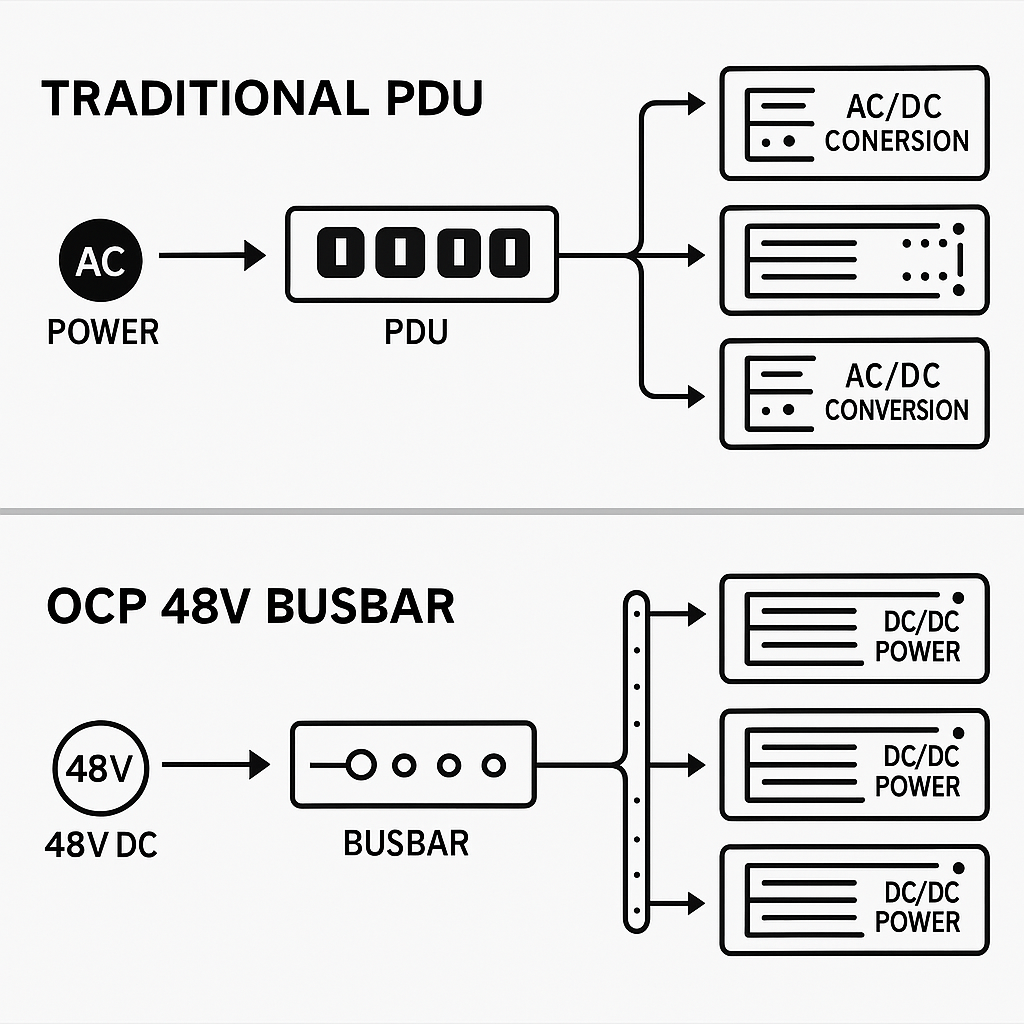Traditional vs. OCP Racks: A Complete Comparison & How to Bridge the Gap
Introduction
In my previous articles, I have already explained what is Open Compute Project and its relavance in India. The data center industry is at a crossroads.
Data center racks are the backbone of modern IT infrastructure, housing servers, storage, and networking equipment. While traditional racks have been the industry standard for decades, OpenCompute Project (OCP) racks have emerged as an open-source hardware alternative designed for hyperscale data centers.
In easier words, While traditional 19-inch racks remain the standard for most enterprises, Open Compute Project (OCP) racks—designed for hyperscale efficiency—are gaining traction.
In this article, we’ll compare OpenCompute racks with traditional data center racks, covering differences in dimensions, design, cooling, power distribution, and efficiency.
But must organisations choose one over the other?
This guide explores:
- Key differences between traditional and OCP racks
- Pros and cons of each approach
- 5 practical ways to integrate OCP designs into legacy data centers
Section 1: Traditional vs. OCP Racks – Head-to-Head Comparison
1. Design & Physical Dimensions

| Feature | Traditional Racks | OCP Racks |
|---|---|---|
| Width | 19 inches (standard) | 21 inches (better airflow) |
| Depth | 600mm–1200mm | 600mm/1000mm/1200mm (Open Rack v2.0) |
| Height | 42U (48U/52U options) | 48U (Open Rack v3.0) |
| Structure | Enclosed (doors, side panels) | Open-frame (no side panels) |
| Mounting | Square/round holes (tool/tool-less) | OpenU (OU) sleds (tool-less) |
Key Takeaway: OCP racks prioritize scalability and airflow, while traditional racks follow long-established standards.
2. Power Distribution & Efficiency

| Feature | Traditional Racks | OCP Racks |
|---|---|---|
| Power Type | AC (120V/208V/240V) | 48V DC busbars |
| Efficiency | ~90-94% (multiple conversions) | 97%+ (fewer conversions) |
| Cabling | Thick power cables per server | Busbar-based (less clutter) |
Key Takeaway: OCP’s 48V DC power cuts energy waste, ideal for hyperscale.
3. Cooling & Airflow

| Feature | Traditional Racks | OCP Racks |
|---|---|---|
| Cooling Method | Air-cooled (hot/cold aisle) | Liquid + air (RDHx, fan walls) |
| Airflow | Restricted (enclosed design) | Optimized (open-frame) |
Key Takeaway: OCP racks enhance cooling efficiency, reducing operational costs.
4. Server Form Factors
| Feature | Traditional Racks | OCP Racks |
|---|---|---|
| Server Size | 1U/2U/4U | OCP sleds (21” wide) |
| Storage | 2.5”/3.5” drives | Disaggregated (JBOD/JBOF) |
Key Takeaway: OCP supports modular, high-density designs.
5. Cost & Deployment
| Feature | Traditional Racks | OCP Racks |
|---|---|---|
| Upfront Cost | Lower | Higher (but better TCO long-term) |
| Best For | Enterprises, colocation | Hyperscale (Meta, Google, cloud) |
Key Takeaway: Traditional racks are cost-effective for enterprises, while OCP racks optimize hyperscale efficiency.
Section 2: 5 Ways to Integrate OCP Designs into Traditional Data Centers
1. OCP-to-19” Adapter Kits
- How: Use conversion trays to mount OCP sleds in 19” racks.
- Best For: Companies wanting minimal changes.
- Vendors: Wiwynn, Delta, Excloud
2. Hybrid Racks (OCP + Traditional)
- How: Mix OCP and traditional servers in the same rack.
- Best For: Gradual migration strategies.
3. OCP-Certified 19” Servers
- How: Deploy OCP-inspired servers (48V DC, OpenBMC) in legacy racks.
- Vendors: Inspur, Wiwynn
4. Retrofit Power & Cooling
- How: Upgrade to 48V busbars and OCP-style cooling (RDHx, fan walls).
- Best For: Efficiency-focused upgrades.
5. Pod-Based Deployment
- How: Designate an OCP “pod” within the existing data center.
- Best For: Large-scale adoption.
Section 3: Which Approach Should You Choose?
| Option | Best Use Case | Cost | Difficulty |
|---|---|---|---|
| Adapter Kits | Testing OCP compatibility | Low | Easy |
| Hybrid Racks | Phased migration | Medium | Moderate |
| OCP-Certified 19” Servers | No rack changes needed | Medium | Easy |
| Power/Cooling Retrofit | Maximizing efficiency | High | Hard |
| Pod-Based Deployment | Large-scale OCP adoption | Medium | Moderate |
Conclusion: The Future Is Flexible
- For enterprises: Start with adapter kits or OCP-certified 19” servers.
- For hyperscale aspirants: Consider pod-based deployment or full OCP migration.
- For efficiency seekers: Retrofit power and cooling where possible.
By blending OCP innovations with traditional infrastructure, businesses can future-proof their data centers without a full overhaul.